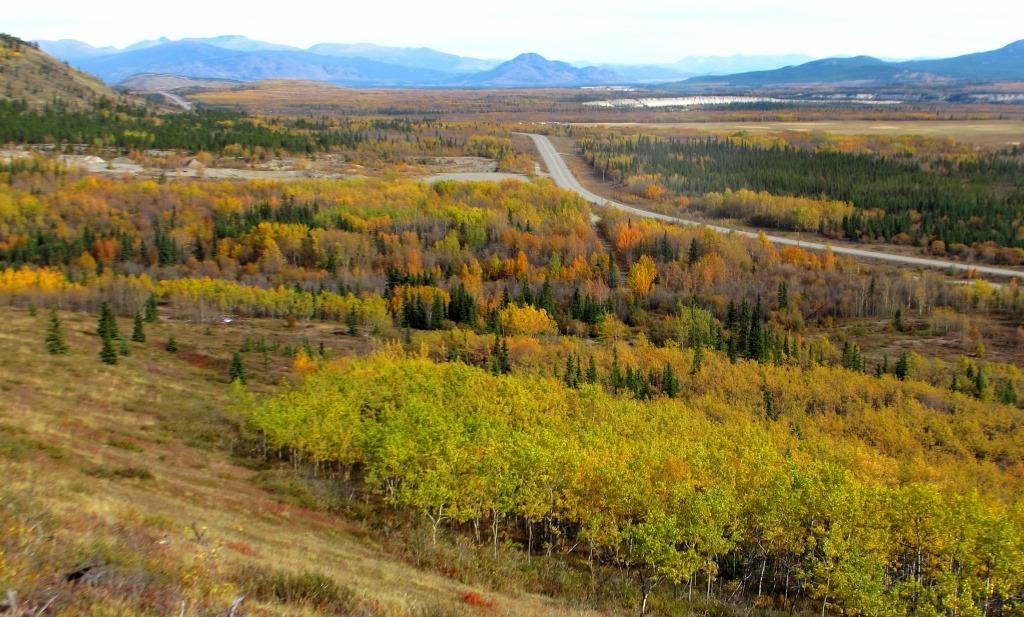
(Gord Allison photo)
On the drive along the Alaska Highway from Whitehorse to Haines Junction near kilometer 1485 is Stony Creek, a stream locally known for its good drinking water. Less than 300 meters to the right (northwest) of the highway and to the west of the creek, a solitary grave lies on a gentle slope within a small grove of aspen trees. This is the resting place of (Robert) John McCoy, a trapper and roadhouse operator who was buried there in 1914.

(Gord Allison photo)
About 60 meters down the slope from the grave is where the house of John and his brother Henry was located beside the Kluane Wagon Road. Just to the southwest is the site of the Stony Creek roadhouse, built in 1904 at the same time as the wagon road, and which the brothers may have been caretakers/operators of at times. These buildings persisted through the construction of the Alaska Highway, but are long gone now.
Surrounding the grave and the old building sites is a large area that became occupied in 1942 by the highway construction and maintenance camp known as ‘956’ for its Alaska Highway milepost distance from mile 0 at Dawson Creek, BC. A November 1943 photo shows the grave within the camp setting, where it was protected and remains today. The nearby old buildings were left undisturbed until at least the time of the photo, but they were destroyed at some point afterward.
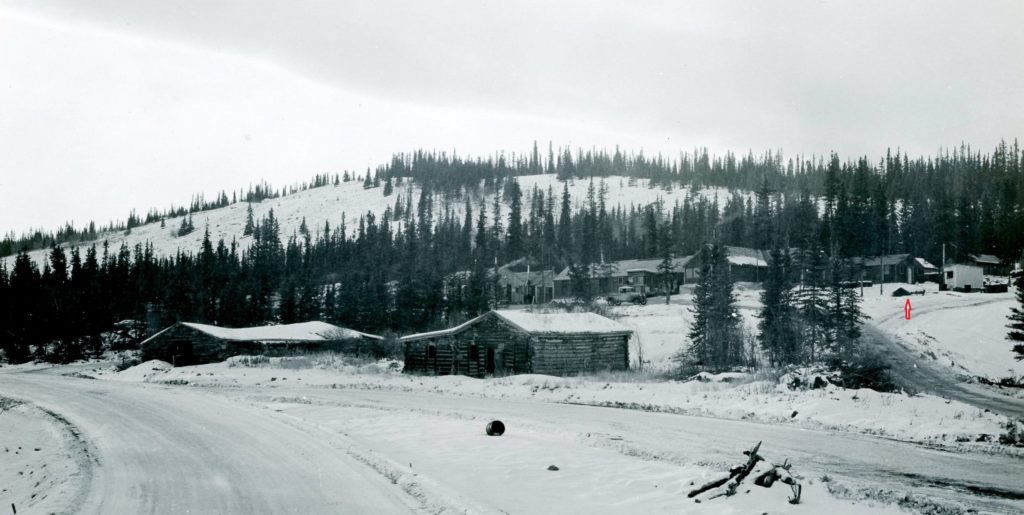
(National Archives & Records Administration, Alaska Highway project, #44-1252-A)
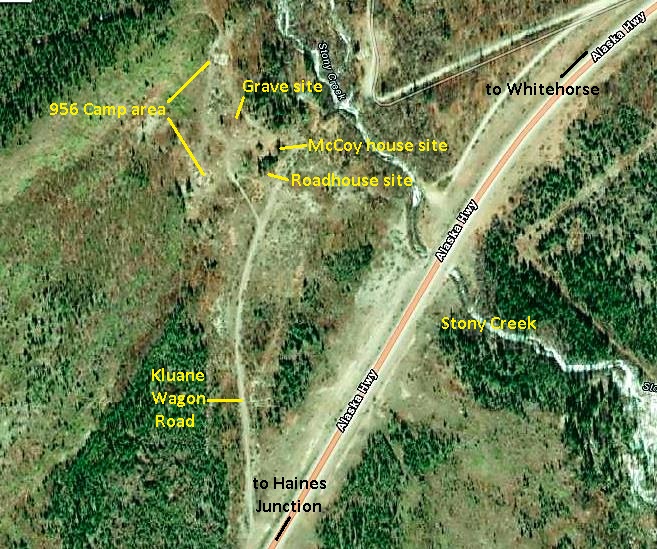
(GeoYukon)
Today, the Stony Creek site is marked by disturbed ground along with wood and metal debris associated with the highway maintenance camp. Contrasted within this is the small but serene setting for the grave of John McCoy, its wooden headboard now almost illegible and the only remaining physical evidence from the Stony Creek roadhouse days of the early 1900s.

(Gord Allison photo)
Background
A small gold rush into the Kluane region occurred in 1903 following the discovery of gold that summer on creeks to the north of Kloo Lake. By the spring of 1904 a trail from Whitehorse was in place that was substantial enough for horse teams to transport equipment and supplies. That fall, a government road into the Kluane region was built off the Dawson-Whitehorse Overland Trail from a point in the Little River area about 32 miles northwest of Whitehorse. This road, most commonly known as the Kluane Wagon Road, went another 122 miles to Silver City at the south end of Kluane Lake. (see links to related articles at end)
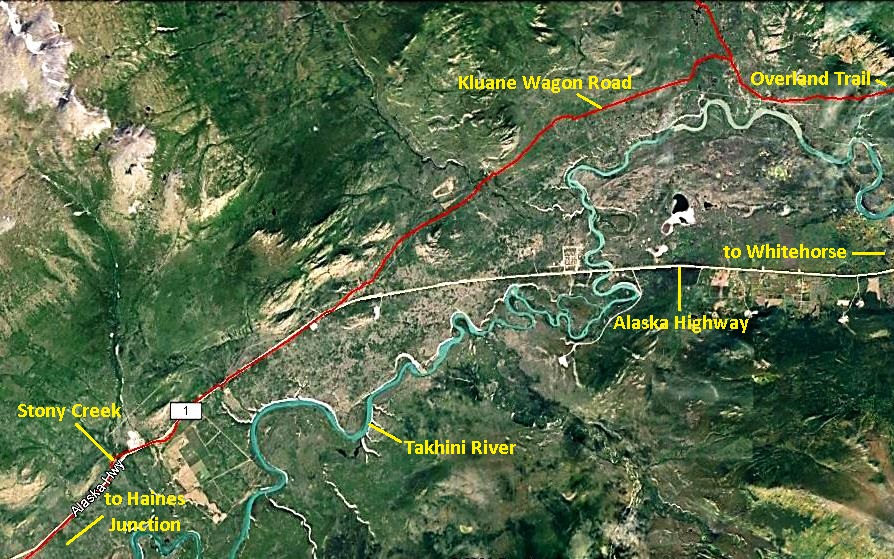
(Google Earth)
As the access into the Kluane region continued to be improved, roadhouses to serve travellers were being built, with at least ten eventually established along or near the wagon road. While the roadhouses at Champagne and Bear Creek, 64 and 114 miles from Whitehorse respectively, operated for several decades, the others mostly ran for only a couple of years until the gold rush and its associated traffic declined. Most were vacated, but remained available for travellers to use until deteriorated beyond the point of usefulness.
The first roadhouse to be reached travelling westward on the Kluane Wagon Road was at Stony Creek at mile 45½, measured from Whitehorse. The builder and first operator of the roadhouse is known, but after the gold rush tapered off it ran sporadically and the details are somewhat hazy, with a number of people involved and at overlapping times, and perhaps using different buildings.
Thomas Hinchcliffe, 1904-06
The Stony Creek roadhouse was started by Thomas Hinchcliffe, who had operated a roadhouse with his wife Elizabeth near Atlin. He was an Englishman and she an American, and they were in the north by at least 1901. In November 1904 Hinchcliffe applied for a 40-acre parcel of land centered on the intersection of Stony Creek and the Kluane Wagon Road. His application was held up for some time because the government was considering establishing a reserve there for a townsite in case the Kluane gold rush became a big deal. There was also a rival application for land for a roadhouse at the same location.
By early January 1905, though he had no authorization to occupy the land, Hinchcliffe was going ahead with construction of buildings there. By March he had “a well-built roadhouse and a stable” built on the site, using nearly all the available timber that was on the land.
In a letter in 1906 to the Crown Land agent, Hinchcliffe enquired about the standing of his land application. On October 31 the agent stated that the townsite question and the rival application were no longer impediments and recommended that the Commissioner approve the application. What the agent could not know was that Hinchcliffe had been found dead the day before in his roadhouse “after a prolonged drinking bout”. Thomas Hinchcliffe was 43 years old, with a wife “someplace on the outside” (of the Yukon), and was buried in Whitehorse.
Drinking was not the only problem Hinchcliffe had. In August 1902 he had been escorted from Dawson to the provincial asylum in New Westminster, BC because he was “of unsound mind”. After being released from there he was back in the Yukon by the time of the gold rush into the Kluane region. His wife was not with him when he died, as she became a resident of Surrey, BC in about 1905. She was in the Yukon in 1907, however, perhaps to wrap up her husband’s affairs which would have included the Stony Creek roadhouse. She lived the rest of her life in Surrey, passing away there in 1944.
The McCoy Brothers, ca. 1907-1914
By the time of Thomas Hinchcliffe’s death in 1906, the Kluane gold rush was over and the region settled into a slower pace of life. The decrease in activity was reflected in the decline in travellers on the Kluane Wagon Road, and most of the roadhouses ceased operating.
The next record of activity at Stony Creek after Hinchcliffe’s death was in the spring of 1909, when brothers (Robert) John and Henry McCoy were living there. They were from Ohio and had been in the Yukon by at least 1907, when they were noted as being miners based in the Whitehorse area, and were both in their 50s.
The McCoy brothers were probably residents of the Kluane area by 1908 because they were part of a New Year’s Day gathering that year at Champagne, 19 miles to the west of Stony Creek. A tongue-in-cheek newspaper article written about the event by Jack Pringle of Shäwshe/Neskatahin (Dalton Post) listed a program of activities that included a solo by Henry McCoy called “Why Our Roadhouse Pays”. There was also what was termed a ‘one-handed address’ by John McCoy on “Rhumatics”, presumably to do with rheumatism that he was afflicted with.
Two recorded visits to the Stony Creek roadhouse in 1909 showed that while the McCoys were primarily engaged in trapping there, they also provided services to whatever travellers came along. The first of these visits was on May 5, when a group of 34 American men travelling on the Kluane Wagon Road to work on the Yukon-Alaska boundary survey in the White River area stopped at the roadhouse. One of them, Ralph E. Robson, wrote the following for a San Francisco newspaper article:
“… we came to the Stony Creek roadhouse, which was kept by two old men. They were characters and typical frontiersmen, who fled at the approach of civilization. These lonely old souls very seldom saw anyone, and our arrival made the day quite an eventful one for them. They threw open their cabin, of two rooms only, and our cook used their kitchen, saving us the trouble of putting up tents.
The main room was about thirty feet square, of rough unhewn logs, the cracks between them were stuffed with mud and moss. Across one end were bunks, three high. A huge stove in the center heated the place, and above the stove on a rack, similar to the ones in all the cabins, was a heterogeneous collection of gloves, mittens, socks and moccasins. The walls were hung with snowshoes, pelts, buckskin coats with fancy beadwork and fringes.
Theirs was a lonely old life, full of hard knocks, but they did not complain, for in Alaska, which is a poor man’s country, at least they were independent. With hunting and trapping and an occasional traveller, they managed to live and get enough to supply their simple wants. One of the old men was hale and hearty, the other was bent and twisted with the rheumatism and was a wreck, yet they went out hunting and trapping in the severest kind of weather.”
This account may have contained a few embellishments and one obvious error (Alaska), but it provides a rare glimpse of this sort of enterprise and the people involved in it. The observation of the roadhouse as being thirty feet square would appear to describe the building that was the McCoys’ house, pictured in the previous black-and-white photo from 1943.
The second recorded visit in 1909 was on August 9 when an American, John Wesley Gebb, was on the Kluane Wagon Road on his way to Alaska and stopped at Stony Creek. He noted the following in his diary: “about 2 PM we arrive at Stony Creek roadhouse, forty-five miles from Whitehorse. McCoy, the roadhouse landlord, has neuralgia in his arms. I help him get dinner. McCoy was mining on the Peace River in 1897. He regales us with his hard-luck story. At 4 PM we are on the road.”
These accounts of John McCoy’s medical plight make it plain that he suffered from it. In the fall of 1911 he spent several weeks in Whitehorse and was planning a trip out of the Yukon in the hope that his rheumatism would be relieved by a change of scenery.
In June 1913 Henry McCoy, his address given as Stony Creek, filed a land application for one acre for a roadhouse. Perhaps it was also to protect his interests there (the house he and his brother lived in), as that same year Harry Chambers of Champagne had a one-acre parcel of adjacent land, which he had been granted four years previously in 1909, surveyed for title.
In June 1914, John McCoy died at Stony Creek at the age of 60 after his long battle with his health issues. He was buried just uphill from his house, with a nicely lettered headboard to mark his resting place.

(Gord Allison photo)

(Gord Allison photo)
In the early 1940s, a man named Charles Lorence who was a civilian employee at the Stony Creek highway camp took a photo of what he captioned ‘Tim McCoy’s grave’, although how he got the name Tim is unknown. In the photo the grave is topped by a low log house with a headboard at one end of it. The headboard has the same shape as the one that is on the grave now, but the log house is no longer there. Perhaps it deteriorated and was replaced by the rudimentary and partly broken fence that now encloses the grave.
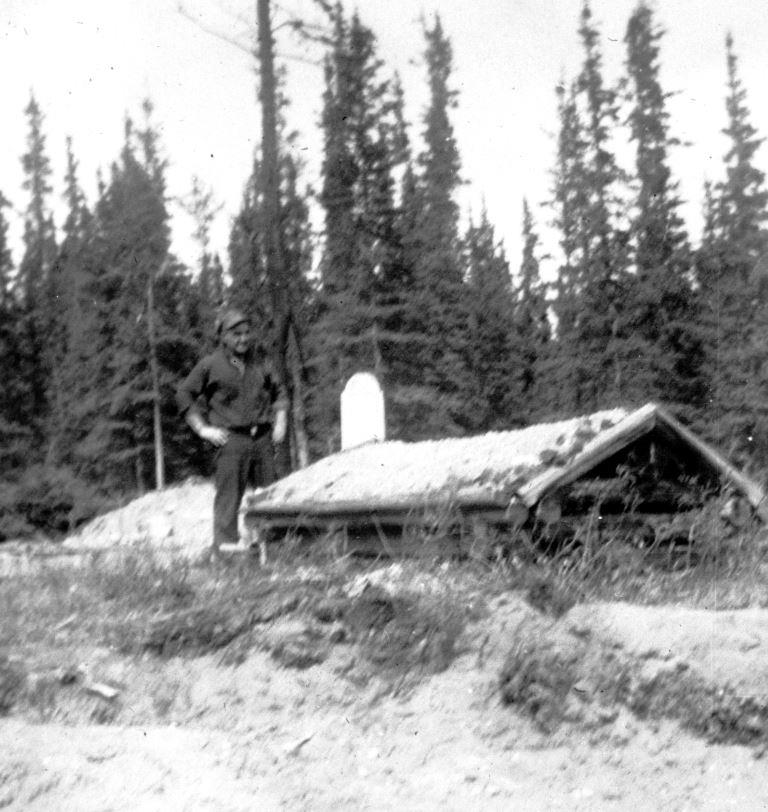
(Yukon Archives, Charles Lorence fonds, Acc. 84/73, PHO 286, #1 – photo has been cropped)
There is no record of Henry McCoy in the Yukon after the 1914 death of his brother John. His land application at Stony Creek had never advanced anywhere, and in 1921 when the government sent him a letter about it, he responded from his native Ohio that he had sold his rights to the land (not that there were any) to Harry Chambers. Henry McCoy remained in Ohio and died there in 1936.
Harry Chambers, 1909-1921
Harry Chambers (also known as ‘Shorty’) was from New York and had come to the Yukon at the time of the Klondike gold rush. He and his wife Annie Kershaw, from Shäwshe/Neskatahin (Dalton Post), established a trading post and other developments at Champagne beginning in 1902. They undoubtedly hosted the previously described New Years 1908 festivities, where Annie played the piano and Harry performed a dance.
In 1909 Harry Chambers applied for one acre of land for an unstated purpose 300 feet west of Stony Creek along the Kluane Wagon Road. His application was approved and the parcel legally surveyed in November 1913 by Henry G. Dickson, a Whitehorse-based Dominion land surveyor. If there were any buildings on the land at the time, they were not identified on Dickson’s survey plan.
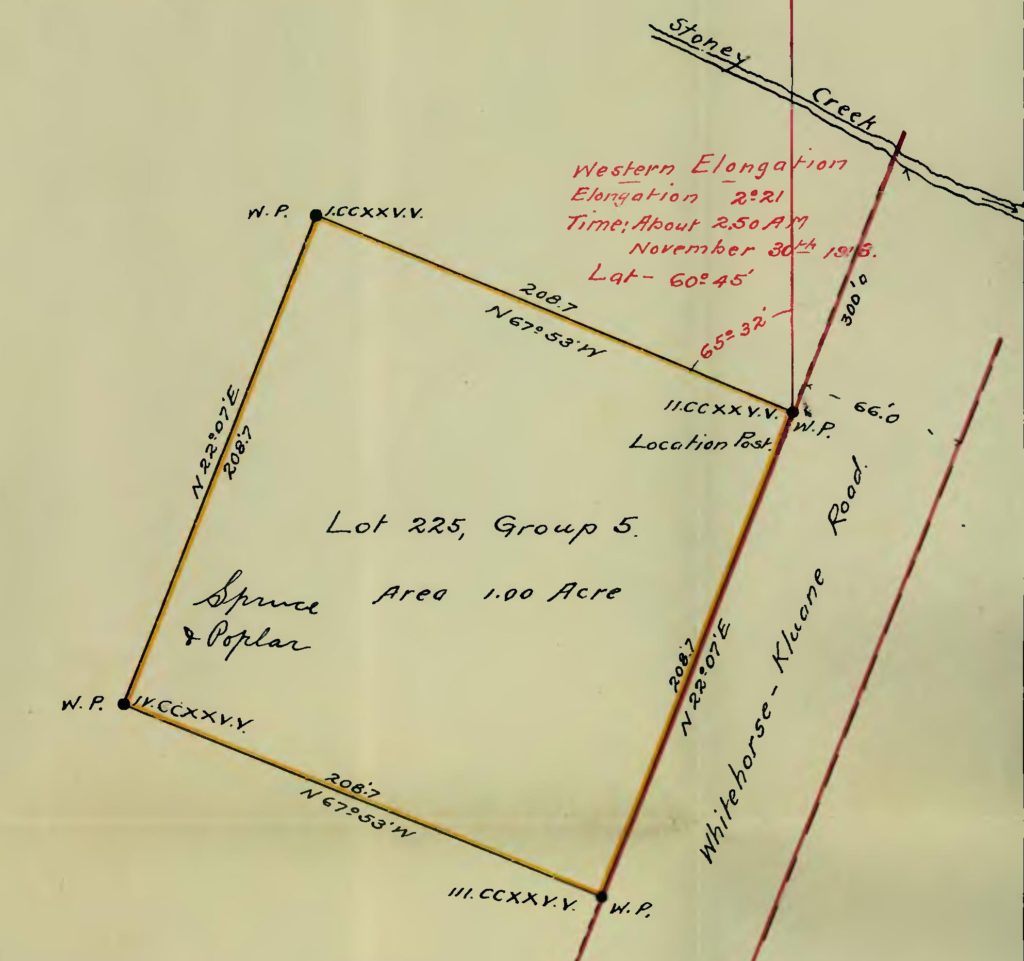
(Canada Lands Survey Records, Field Book #14783)
In October 1914, about a year after the survey, the government asked Dickson to provide a sketch of the Stony Creek area to clarify the land situation there in order to determine where Henry McCoy had applied for the previous year. The hand-drawn sketch that Dickson furnished based on memory is quite helpful for telling the Stony Creek story.
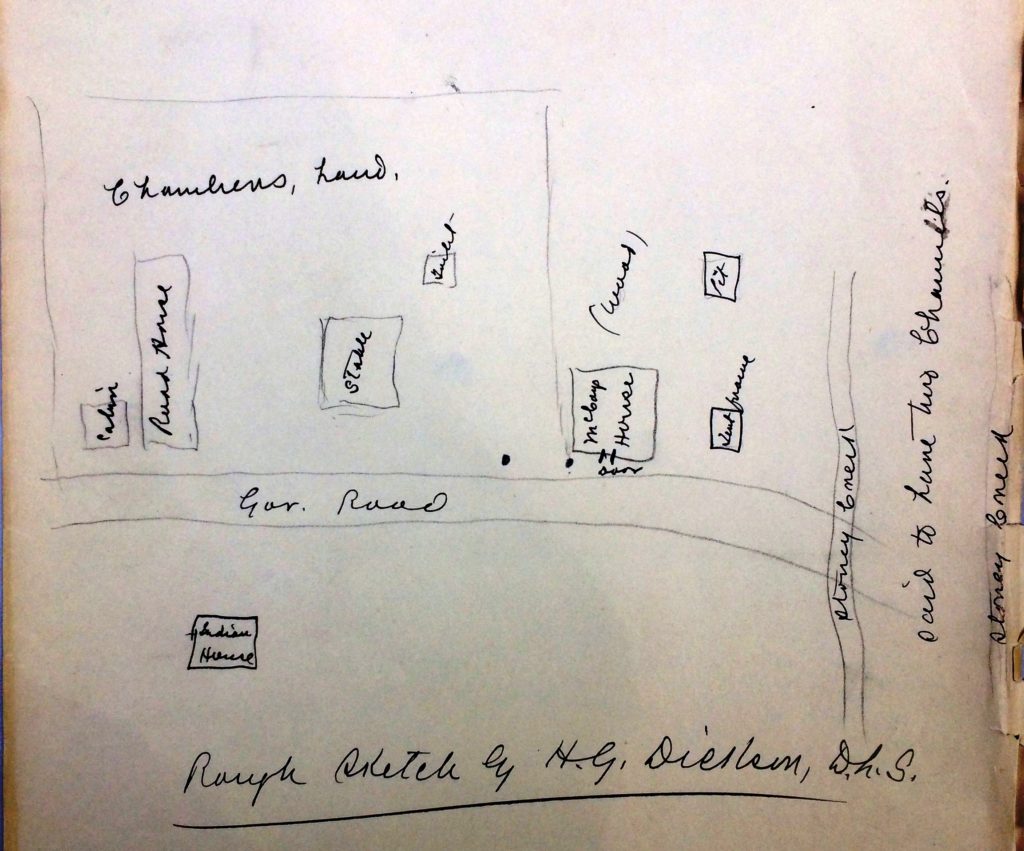
(Yukon Archives, GOV 1647, File 25980)
Dickson’s sketch showed the Chambers land that he surveyed in 1913 as containing a cabin, roadhouse and stable, which may be the original buildings put up by Thomas Hinchcliffe in 1904-05. The other useful piece of information Dickson’s sketch showed is that the log house that appears in later US Army photos is where the McCoy brothers lived.
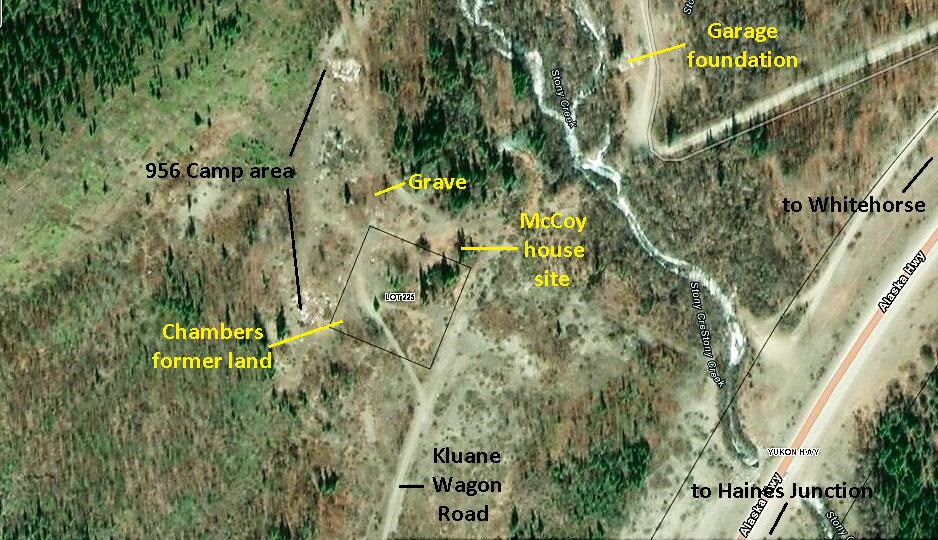
(GeoYukon)
It is not known if Chambers actually operated a roadhouse or did anything with the land he acquired at Stony Creek. As for the undefined parcel of land that he had purchased from Henry McCoy, Chambers later informed the government that he relinquished any interest in it.
John and Elizabeth Warne, 1913-14
In the fall of 1913, when the McCoy brothers were still living at Stony Creek and Harry Chambers was perhaps developing on his parcel of land there, John and Elizabeth Warne entered the roadhouse picture.
John Warne, originally from Ontario, participated in the Northwest Rebellion of 1885 as a personal dispatch rider for General Middleton. In February 1900 at Vancouver, he married Elizabeth Mills, who had recently emigrated from Ireland. They headed that same year to the Klondike, walking in from the coast over the Chilkoot Trail and then travelling by raft through Miles Canyon and the Whitehorse Rapids and all the way to Dawson City.. Their son Howard was born there the following year, and they were still living in Dawson at the time of the 1911 census.
It may have been a new opportunity created by the Chisana gold rush in 1913 that caused the Warnes to leave Dawson. New gold discoveries just west of the Yukon border in the White River area of the southwest Yukon drew prospective gold miners from many directions, and the Kluane Wagon Road was one of the routes they used.
One newspaper article said that John Warne erected a new roadhouse at Stony Creek in the fall of 1913, but it is not known where. The same article said that in the following summer of 1914 Warne was putting up some buildings for Harry Chambers, so perhaps the roadhouse had been built on Chambers’ land.
In mid-July of 1913, while the Warnes would have been preparing for their new venture at Stony Creek, Elizabeth Warne’s 25-year old sister Alice Mills came from Ireland to live with them. The two sisters hadn’t seen each other since Elizabeth left Ireland about 15 years before. Alice would go on to be a Yukoner for the rest of her life.
John Warne ran the roadhouse over the winter of 1913-14 while his wife and son stayed in Whitehorse so that 12-year old Howard could attend school. There they lived in Sam McGee’s cabin, which caught on fire in the spring of 1914 from a chimney spark igniting the roof. Fortunately, action by local people before the fire department could arrive saved this now-historic building from ruin.
The roadhouse business along the Kluane Wagon Road was not very good, as the anticipated traffic did not materialize and many of the gold rushers were camping out instead of using roadhouses. The Warnes may have operated theirs during the summer of 1914, but there is no information about them being at Stony Creek after 1914. By October 1915 they were living in Whitehorse in a house that Warne had built there.
John Warne went on to do carpentry and construction work over the next few years in Whitehorse and in the Conrad area. During the influenza epidemic of 1919-20, Elizabeth provided nursing and cooking services at Champagne and the Choutla School in Carcross. The Warnes left the Yukon in the 1920s to make a new home in Terrace, BC, but sometime after that they separated. John Warne died in Terrace in 1944 at the age of 80.
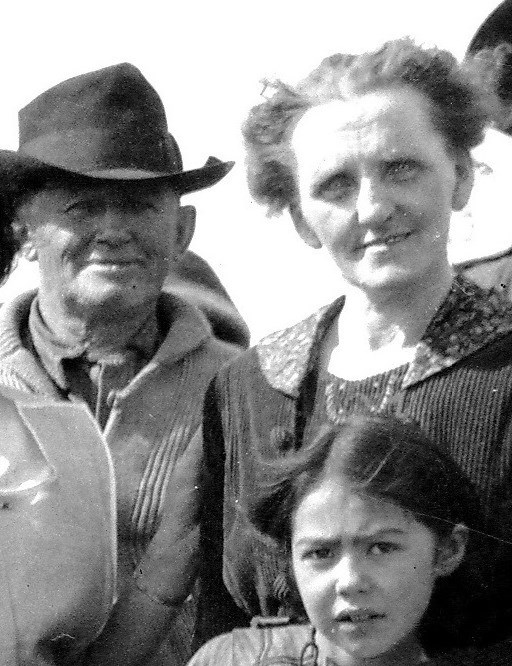
(Yukon Archives, Watson Family fonds, Acc. 2017/21, PHO 529, #25)
After the Yukon, Elizabeth Warne lived mostly in BC and Alberta, at times with her son Howard, but she returned north several times to visit her family in Whitehorse as well as to work as a cook on the White Pass & Yukon Route railway at stations such as Log Cabin and Pennington. On at least one occasion she had her young granddaughter Mildred with her. Elizabeth died in Vancouver in 1965 at age 87.
Elizabeth (Mills) Warne still has family in the Yukon 120 years after coming here. This is due to her sister Alice meeting stage coach driver Alex MacLennan and marrying him in Dawson City in October 1914. The MacLennans had three daughters, one of whom was named Betty, presumably for her aunt Elizabeth, and she married Charlie Taylor of the well-known Yukon Taylor family. Alice (Mills) MacLennan died in Whitehorse in 1970, leaving a number of descendants in the Yukon.
Alaska Highway Construction, 1942-43
After John and Elizabeth Warne gave up the roadhouse operation at Stony Creek in 1914, there is no record of any activity of note occurring there until the US Army built the ‘pioneer road’, the precursor to the Alaska Highway, through the area in the summer of 1942. From Whitehorse the road followed the Dawson-Whitehorse Overland Trail for the first 32 miles and then the Kluane Wagon Road for much of the way to Silver City. One of the construction camps, later a maintenance camp, was established at Stony Creek, perhaps the good drinking water source there being a factor.

(Gord Allison photo)
The establishment of the camp at Stony Creek resulted in photos taken by the US Army and civilian contractor employees that shed some light on the earlier history there. The photo of John McCoy’s grave is an example of this, as are two that show where the McCoy house and other buildings were located.
The photos also show an early view of the highway camp that was established along the slope upwards from the roadhouse site as well as a large equipment maintenance garage beside the road on the east side of the creek. The garage was constructed in the winter of 1942-43 by an American civilian contractor, Joe A. Jussel of Seattle. The concrete foundation of this building still remains near the start of a residential driveway.
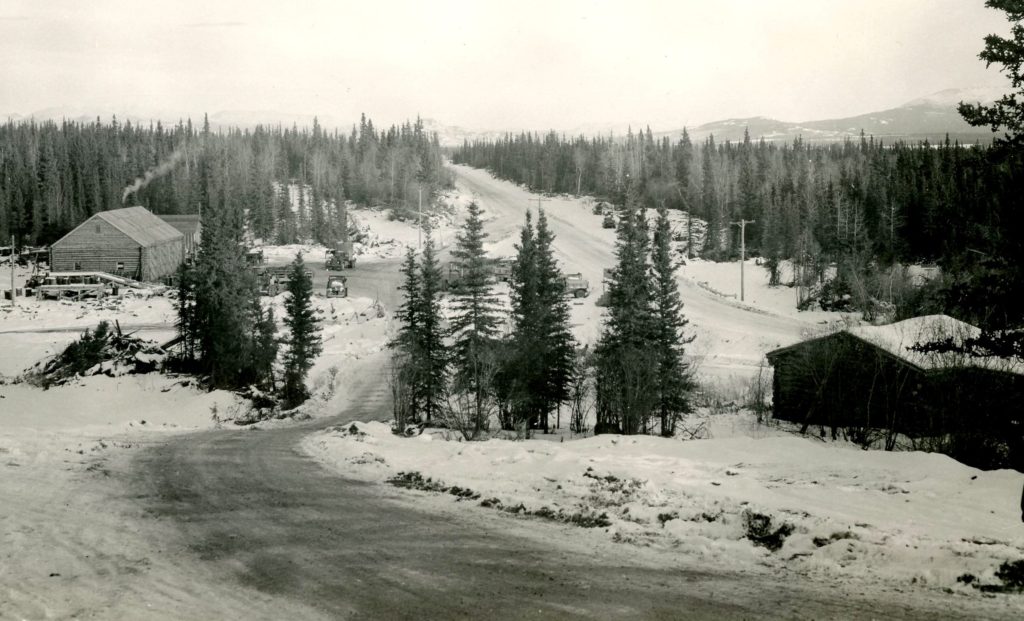
(National Archives & Records Administration, Alaska Highway project, #44-1252-B)

(Gord Allison photo)
After the Highway, 1940s – Present
The Mile 956 highway camp continued to operate as a maintenance camp following the construction of the highway. It continued this role until the late 1960s, when it was shut down and the employees transferred to other camps. By that time the highway had been relocated about 200 meters to the east (as measured at the creek crossing) from the original pioneer road location along the Kluane Wagon Road.
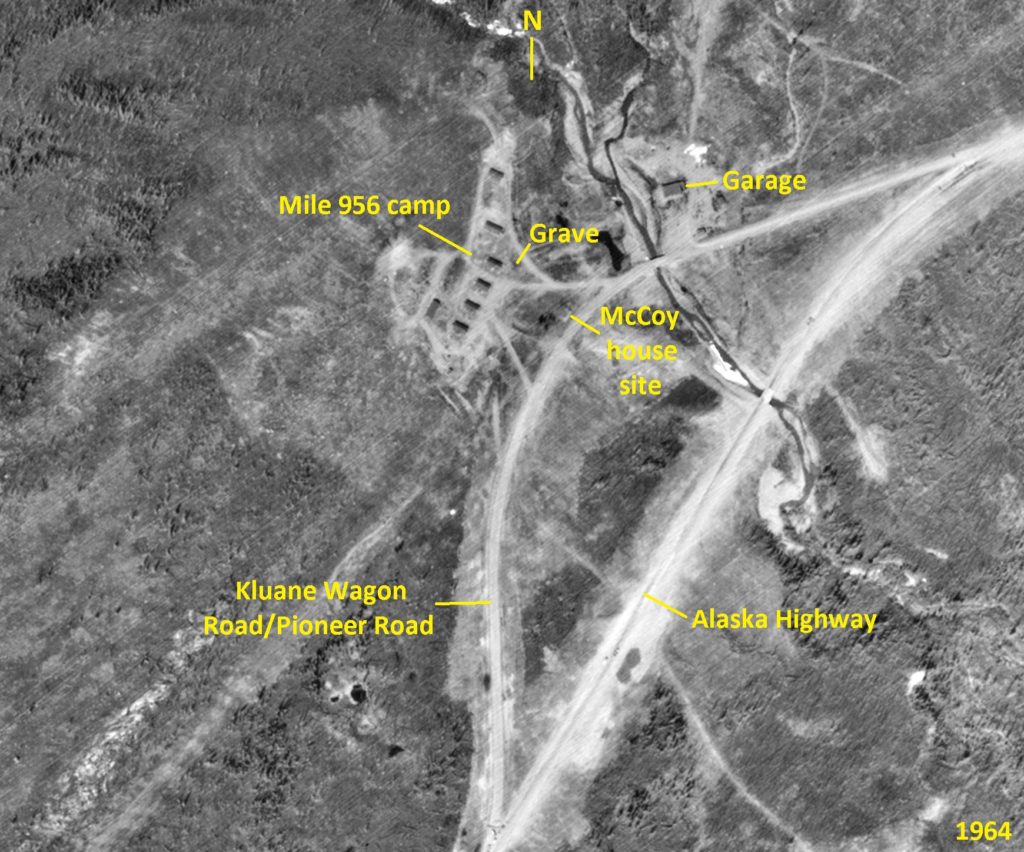
(A18400, #101)
In July 1958 a human-caused forest fire that started from the camp area ended up dramatically changing the landscape in much of the Takhini River valley. The fire merged with another one that had started around the same time a few miles to the west and spread eastward, causing considerable concern for the city of Whitehorse for a time.
The fire burned all around the maintenance camp, but it does not appear to have done any damage, which must have been due to a significant amount of effort as well as luck. Others in the area were not so fortunate, however, with destructive consequences from the fire at some properties.
The spruce forest cover at Stony Creek that appears in the photos from the 1940s highway construction era is very slow in returning. 62 years after the fire, the vegetation shows the area to still be in a long post-fire recovery period.
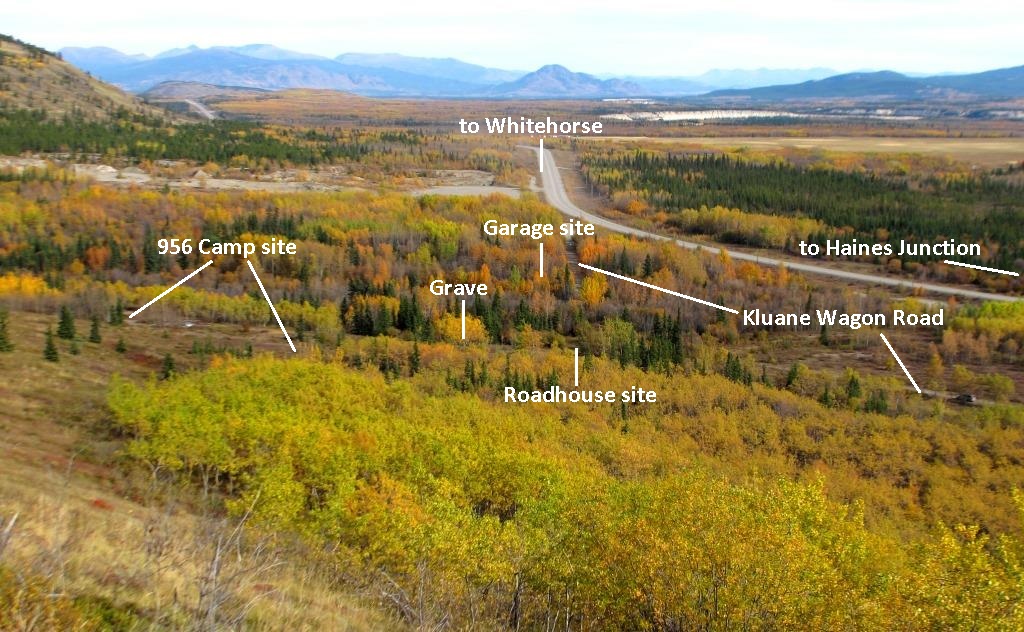
(Gord Allison photo)
At the Stony Creek site, the grave of Robert John McCoy has survived land disturbance and human activities all around it, the forest fire of 1958, and perhaps other potentially damaging events. After almost 107 years in place, it still bears witness to some of the history of Stony Creek.
Links to related articles: Kluane Wagon Road and Ruby Camp
Well researched and informative piece. Thanks Gord!
Thank you Sheila. I appreciate it.
Very good Gord . Another great read. So there would be one in between Stoney Creek and Champagne?Was there one near Cracker Creek?
Boyd
Thanks very much Boyd. This started out as a story on all of them, except for Bear Creek which I’ve already done, and Champagne, which is a different kettle of fish. However, Stony Creek had enough info to be on its own, which most don’t. I will be doing the others at some point. Yes, there was one between Stony Creek and Champagne at Mendenhall crossing and also one at Steamboat Landing, so four of them within 20 miles of each other. And there was one about 3 km. east of Cracker Creek on the river that was called Big Bend. I appreciate your interest.
Absolutely love reading all of your historic articles.
So well researched and well written !
Thank you Heinz, I appreciate the feedback. Still hope to link up with you on the Yukon River one day.
Wonderful story and great research. Thank you.
Thank you for the feedback.
Thanks for the great article Gord. I wasn’t aware of my great great grandfather connection to Stoney Creek
Thank you too, Shadelle. I don’t know how strong or long-lasting the connection was, but in a couple of big game hunting articles or books a few years later there is reference to them using a cabin of his after leaving Champagne on their way to Whitehorse. I assume it would have been at Stony Creek, but no proof of that. I’ve seen that he had connections at one time or another to a lot of places besides Champagne, like Canyon, Steamboat, Six-Mile Lake, Takhini Crossing, and of course Whitehorse. He was a busy guy. Good to hear from you.
Well researched. I love Yukons’ history. I never knew about this area and have traveled by it dozens of times since 1961. The next time I’m in the area I will stop and look around. My dad introduced me to some of the Chambers from Champagne in the 1960s, great people. Thank you for posting.
Thank you, Donna. I remember you when you lived in Haines Junction, although I was a few grades behind you. Glad you know about Stony Creek now, it was a learning experience for me too. There are a number of spots like that along or near the highway with little-known histories.
Very well written and researched. Had not seen the pic of Shorty Chambers before. thanks
Thank you for the nice comment, Delores. There is another picture with Shorty in it and also one of his wife Annie in an article in this blog called ‘Watson Family Yukon Stories’. I believe the one of Annie is the first photo that some members of the Chambers family had seen of her.
Just read your wonderful story of Stony Creek.
It cought my interest as my son just purchased a parcel of land and buildings at Canyon Creek, the purple house stands out and gets all the attention!
I would like to. Know if there is any truth to the story we were told that this was the site of Sam Magee’s road house and
The purple house was the head quarters for USO troops entertaining American military working the highway construction.
If you have any information you could share with me I would love to hear it or ‘read about it’
Thanks ever so much Gord
Red Lewis
Hi Red, thanks very much for your comments. You and your son undoubtedly know that he bought what was originally the CNT repeater station site, and at least one of the buildings still there was part of that complex. I haven’t heard of the USO coming to Canyon to entertain troops working on the highway, but I suppose it is a possibility that some research could verify. Sam McGee and a couple of partners did build a roadhouse at Canyon in 1904, but the location is not certain. My intuition is that it was between the outhouses (by the parking area) and the river, on the north side of the Kluane Wagon Road, and therefore a ways off your son’s property. I don’t have plans on the horizon to do a blog story on Canyon Creek, but I can e-mail you and/or your son with some additional information if you wish. You can reply to me at gordallison@northwestel.net if you like. Thanks again. Gord